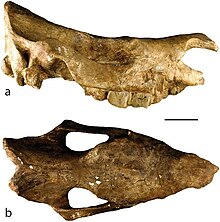Dihoplus
| Dihoplus Temporal range:
| |
|---|---|

| |
| Dihoplus schleiermacheri holotype skull | |
| Scientific classification | |
| Domain: | Eukaryota |
| Kingdom: | Animalia |
| Phylum: | Chordata |
| Class: | Mammalia |
| Order: | Perissodactyla |
| Family: | Rhinocerotidae |
| Tribe: | Dicerorhinini |
| Genus: | †Dihoplus Brandt, 1878 |
| Type species | |
| †Rhinoceros schleiermacheri Kaup, 1832
| |
| Species | |
| |
Dihoplus is an extinct genus of rhinoceros that lived in Eurasia from the Late Miocene to Pliocene.[1]
Description
[edit]
Species of Dihoplus were large rhinoceroses, with the body masses of Dihoplus schleiermacheri and Dihoplus pikermiensis estimated at 2,122 kilograms (4,678 lb) and 1,100 kilograms (2,400 lb) respectively.[2] The head bore two horns. The nasal septum was not ossified, with a nasal notch above the frontmost premolars. The toothrow is placed posteriorly within the skull. The first upper premolar is absent, though the lower second incisor is present.[1]
Taxonomy
[edit]Members of Dihoplus were long placed in Dicerorhinus (which contains the living Sumatran rhinoceros). Sometimes these species are placed in the related Stephanorhinus. The genus is now generally considered distinct,[3] though there is still debate as to which species should be included; for example, Deng (2011) listed Merck's rhinoceros (Stephanorhinus kirchbergensis) under Dihoplus.[4] Species recently placed in the genus include:[5]
- D. schleiermacheri (Kaup, 1832) the type species of the genus, known from Late Miocene of Europe, with the type specimen being known from Eppelsheim, Germany.[5]
- D. pikermiensis (Toula, 1906), known from the Late Miocene of Europe, originally placed in the genus Stephanorhinus.[5]
- ‘D.’ bethlehemsis Pandolfi, Rivals and Rabinovich, 2023, known from Pliocene aged deposits from Bethlehem in the Levant.[5]
"D." megarhinus (de Christol, 1834) from the Late Miocene-Pliocene of Europe, Anatolia, China and Transbaikalia,[1][5] since 2021 has been placed instead in the genus Pliorhinus along with "Dicerorhinus" miguelcrusafonti from the Pliocene of Europe.[6][7] "D." ringstoemi is either considered a synonym of "D." megarhinus[1] or placed as a separate species within Pliorhinus.[8]
The monophyly of the genus has been questioned, with some studies suggesting that D. pikermiensis is more closely related to Stephanorhinus and Coelodonta (which contains the woolly rhinoceros) than to the type species D. schleiermacheri.[7]
Morphological phylogeny after Pandolfi (2023), excluding living African rhinoceros species.[7]
| ||||||||||||||||||||||||||||||||||||||||||||||||||||||||||||||||||||||||||||||||||||||||||||||||||||||||||||||||
Ecology
[edit]D. pikermiensis and D. bethlehemsis are suggested to have been browsers.[9][5]
References
[edit]- ^ a b c d Pandolfi, Luca; Gasparik, Mihály; Piras, Paolo (2015). "Earliest occurrence of "Dihoplus" megarhinus (Mammalia, Rhinocerotidae) in Europe (Late Miocene, Pannonian Basin, Hungary): Palaeobiogeographical and biochronological implications". Annales de Paléontologie. 101 (4): 325–339. Bibcode:2015AnPal.101..325P. doi:10.1016/j.annpal.2015.09.001.
- ^ Mallet, Christophe; Billet, Guillaume; Cornette, Raphaël; Alexandra Houssaye, And (2022-11-02). "Adaptation to graviportality in Rhinocerotoidea? An investigation through the long bone shape variation in their hindlimb". Zoological Journal of the Linnean Society. 196 (3): 1235–1271. doi:10.1093/zoolinnean/zlac007. ISSN 0024-4082.
- ^ Tong, Hao-wen (2012). "Evolution of the non-Coelodonta dicerorhine lineage in China". Comptes Rendus Palevol. 11 (8): 555–562. Bibcode:2012CRPal..11..555T. doi:10.1016/j.crpv.2012.06.002.
- ^ Deng, T. (September 2, 2011). "Out of Tibet: Pliocene Woolly Rhino Suggests High-Plateau Origin of Ice Age Megaherbivores". Science. 333 (6047): 1285–1288. Bibcode:2011Sci...333.1285D. doi:10.1126/science.1206594. PMID 21885780. S2CID 8913866.
- ^ a b c d e f Pandolfi, Luca; Rivals, Florent; Rabinovich, Rivka (January 2020). "A new species of rhinoceros from the site of Bethlehem: 'Dihoplus' bethlehemsis sp. nov. (Mammalia, Rhinocerotidae)". Quaternary International. 537: 48–60. Bibcode:2020QuInt.537...48P. doi:10.1016/j.quaint.2020.01.011. S2CID 213080180.
- ^ Pandolfi, Luca; Pierre-Olivier, Antoine; Bukhsianidze, Maia; Lordkipanidze, David; Rook, Lorenzo (2021-08-03). "Northern Eurasian rhinocerotines (Mammalia, Perissodactyla) by the Pliocene–Pleistocene transition: phylogeny and historical biogeography". Journal of Systematic Palaeontology. 19 (15): 1031–1057. Bibcode:2021JSPal..19.1031P. doi:10.1080/14772019.2021.1995907. ISSN 1477-2019. S2CID 244762077.
- ^ a b c Pandolfi, Luca (April 2023). "Reassessing the phylogeny of Quaternary Eurasian Rhinocerotidae". Journal of Quaternary Science. 38 (3): 291–294. Bibcode:2023JQS....38..291P. doi:10.1002/jqs.3496. hdl:11563/163194. ISSN 0267-8179. S2CID 256167036.
- ^ Li, Shijie; Sanisidro, Oscar; Wang, Shiqi; Yang, Rong; Deng, Tao (March 2024). "New materials of Pliorhinus ringstroemi from the Linxia Basin (Late Miocene, eastern Asia) and their taxonomical and evolutionary implications". Journal of Mammalian Evolution. 31 (1). doi:10.1007/s10914-023-09698-w. ISSN 1064-7554. S2CID 267352083.
- ^ Hullot, Manon; Antoine, Pierre-Olivier; Spassov, Nikolai; Koufos, George D.; Merceron, Gildas (2023-08-03). "Late Miocene rhinocerotids from the Balkan-Iranian province: ecological insights from dental microwear textures and enamel hypoplasia". Historical Biology. 35 (8): 1417–1434. Bibcode:2023HBio...35.1417H. doi:10.1080/08912963.2022.2095910. ISSN 0891-2963. S2CID 251046561.









